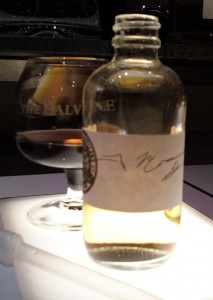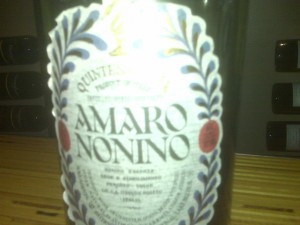Matt’s Signature Balvenie

Normally, Balvenie is not a brand that inspires me to great oration. To my palate, the young Balvenies are so uninspiring that I have never made it to the end of a tasting table. Richard tells me the 20yo is quite nice and I will make an effort to try that in the future. However, what whisky geek could pass up the opportunity to blend their own single malt? I approached this event with unadulterated schoolboy glee and I was not disappointed in any way.
The class took place at Astor Center in NYC and was lead by Dr. Whisky (Sam Simmons, US brand ambassador for Balvenie) and David Mair (Balvenie’s global ambassador). When I take my seat on the front row, I am greeted by a lovely young woman who offers me some prosecco to “get [me] started.” Then, as I admire the Balvenie branded tasting diary and the various glasses, bottles, and droppers at each station, both Sam and David come over to introduce themselves. This is already looking like a good event.
Sam starts by telling us a little about Balvenie Signature 12yo Batch #1 (voted “Best Speyside” in a blind tasting for the New York Times, etc.). We taste Batch #1 (no longer available, btw). Sam then hands proceedings over to David for a little history about whisky in general and Balvenie specifically. I’m not going to get too technical, but a few things stand out about Balvenie as a distillery. First off, Balvenie is the only Speyside distillery that malts their own barley on a traditional malting floor. Not all the barley they use is from these maltings, but a good portion. The fuel for these maltings comes mostly from anthracite (smokeless coal), but they add a small amount of peat for flavor. Additionally, a portion of the barley used is grown on the premises. Throw in custom copper pot stills and you have a truly handcrafted product.
“So what does it taste like,” you ask. Patience, my friends. Sam somehow convinced the master blender (David Stewart for those taking notes) to part with a few bottles of whiskey that he uses to blend Balvenie Signature 12yo. This was a real treat, since these whiskies are not commercially available. Balvenie Signature is comprised of three 12yo single malts: one aged in bourbon casks, one aged in sherry casks, and one aged in refill whisky casks (casks that first held bourbon, then Balvenie whisky). Although from the same source whisky, each of these spirits have distinctive characteristics.
The bourbon cask produces an amber-colored whisky. I really enjoyed this. If Balvenie bottled this, it would be my whisky of choice more often than not. With a heavenly nose of malt, vanilla, and caramel and a palate that replicates the nose plus maple syrup, this is one for the books. When comparing it to the Signature, I can find where it lives in the blend. It seems to be responsible for most of the flavor profile.
The sherry cask gives the Signature most of its color. This whisky is deep and dark, almost a jewel tone. The nose is complex. Notes of black pepper, cloves, tamari, bacon, and celery fill the nose along with a touch of sweetness. The palate is very powerful and tastes of roasted hazelnuts, Christmas spices and sherry (of course). On it’s own, this one is a bit much, but it sits nicely in the back of the blend.
Finally, the refill whisky cask is very pale in color. The nose is remniscent of fresh fruit and licorice. The palate is overwhelmed with licorice. Unlike the herbal licorice of an Islay malt, the licorice of this dram is more like a classic Brach’s black jelly bean.
After sampling all this, we had the opportunity to blend our own Balvenie Signature. You can see mine in the photo above. This was great fun. We compared ours to Batch #1, but the intent was to come up with our perfect blend not necessarily to match David Stewart’s creation. I was feeling pretty good about mine, thinking I could be a master blender some day. Then, Sam brought out Balvenie Signature 12 yo Batch #2 (available in June for $52.99). I have to bow to the superior skills of Mr. Stewart. Mine was good, but his impeccable ability to create a multi-layered masterpiece was awe inspiring. I could taste the elements of the construction. Even the candy licorice flavor floated across the palate like a thin sheen of oil on clear water. However, Balvenie Signature is greater than the sum of it’s parts. I for one, will be standing at the door when this hits the shelves.
In conclusion, this is the best whisky event I have ever attended. I gained a greater appreciation for what blenders/distillers go through to create all this wonderful whisky. Thanks to Sam, David, and the folks at Astor Center for putting this together. I would love to see more classes like this.
Drink well, drink responsibly.
-Matt



